Ute Zimmermann came to the Gowanus neighborhood in 2011 for a lovely loft apartment, but she stayed for the toxic sludge.
After falling in love with the neighborhood’s peculiar charm–nowhere else in the city can you watch the sunset as you walk over a canal, looking down to see, in her words, “poop foam flowing underneath you”–Zimmermann saw the neighborhood grow in popularity with tourists as well. So in October 2015, she opened a pop-up shop with local art and souvenirs, celebrating the unlikely appeal of the smelly canal and its gritty surroundings.
Zimmermann planned to run the shop for three months as an arts project.
“The response was so fun,” she said, that “we kept going.”
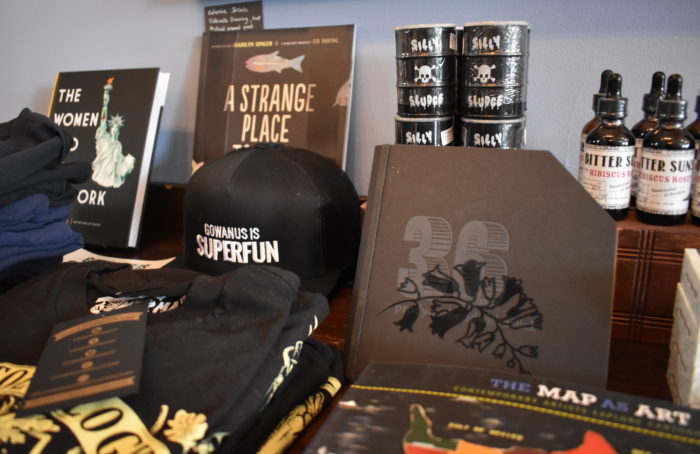
Many items in the shop make playful reference to the canal’s status as a toxic-waste site
Later this year, the Gowanus Souvenir Shop, which Zimmermann describes on the store’s website as “part small town tourist stand, curio shop, antique books and map store rolled into one,” will mark its third anniversary.
Walking by the storefront at 567 Union S., visitors can pop their head into a painted photo board to pose as the Creature from the Black Lagoon. The B-movie horror icon is a theme in the shop, including T-shirts, It Came From the Gowanus Canal comic books, and two posters Zimmermann commissioned for the shop.
For other products, Zimmermann doesn’t need to draw on fiction. The Gowanus was held in such low regard for so many years that one postcard draws its shock value simply from a newspaper headline: “VERY VILE. The Disgusting Condition of the Gowanus Canal. A Nuisance Which is Seriously Affecting the Health of South Brooklyn People.”
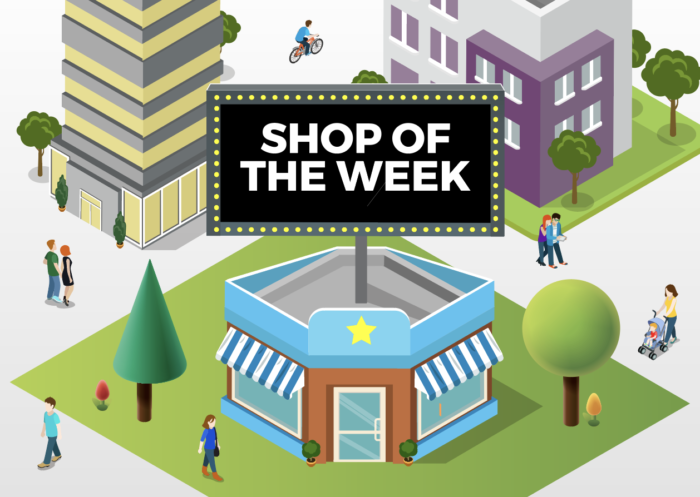
This is the second installment of a new feature on The Bridge, focusing on retail stores in the borough
The canal, polluted by long-gone industrial plants and current sewage overflow, is a Superfund site with a cleanup in progress. But the neighborhood’s accretion of quirky businesses and artists, which had moved there over the years for cheaper rent, created a critical mass that has in recent years turned it into a kind of urban amusement park and events district that is now attracting large real-estate investment. Under a plan released by the city this week–it’s the precursor to a rezoning proposal, which is expected this winter–the neighborhood would become much more densely populated, with new buildings up to 17 stories in some areas.
For merchants like Zimmermann, the business impact of Gowanus’ gentrification cuts both ways. “It hasn’t helped me as a renter because I’ll get pushed out eventually,” she said. But in the meantime, more attention to the neighborhood brings more tourists and other customers, some of whom buy art to furnish their new apartments. Others buy more affordable items like Silly Sludge putty, Toxic Waste candy, and joke T-shirts for fictitious organizations like the Gowanus Swim Team and the Gowanus Tea Company, which is “rich in the spices of Brooklyn.”
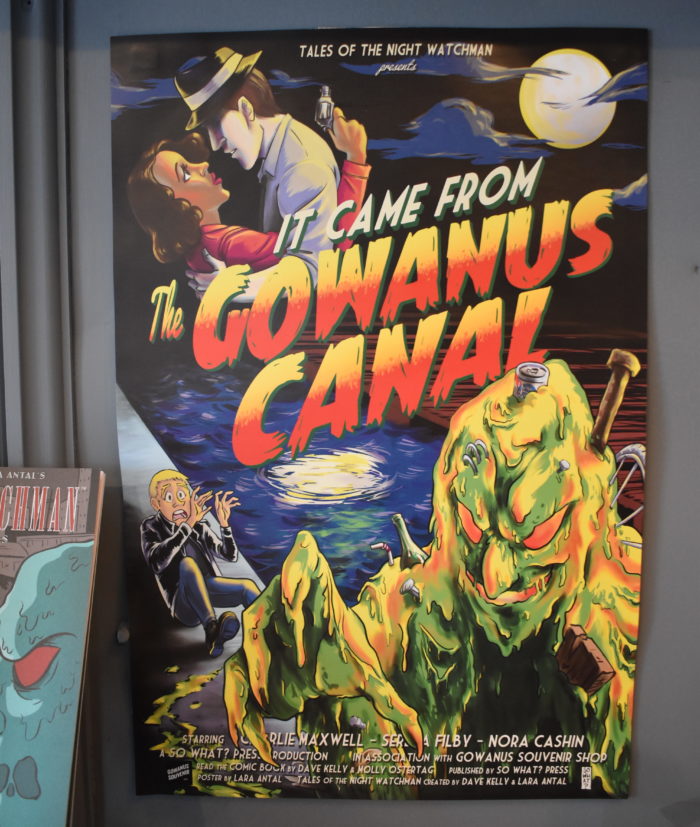
Posters and a comic-book series use the canal as a setting for stories about creepy creatures
Acknowledging that “people like me moving in” is part of gentrification, Zimmermann wants the neighborhood to keep its peculiar character, and she tries to preserve its history at the shop. It includes a small museum of objects found in the neighborhood.
Zimmermann also collects stories of the neighborhood’s past, some of which are probably … not strictly true. Her favorite customers are old-timers who tell her about the days when kids didn’t play on President Street because the mafia operated there, or how there used to be so many rats by the canal that residents would shut their windows to keep the rodents from jumping into their homes.
While the neighborhood now has luxury apartments touting such amenities as a “waterfront esplanade park,” its exotic appeal continues to draw tourists. En route to the canal on Union Street, many wander into Zimmermann’s jokingly self-proclaimed “Official Visitor Center.”
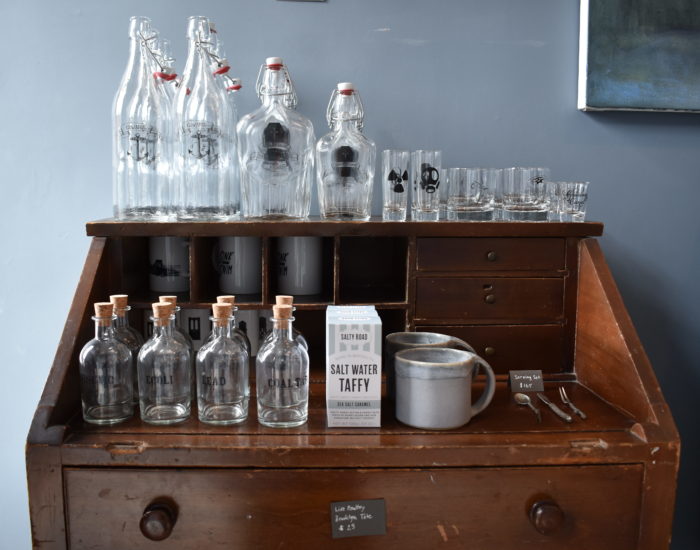
Old-timey bottles resemble the kind that people probably used to toss into the canal
As she was discussing where recent visitors had come from–Germany, Denmark–four women from Switzerland walked in, as if on cue. Zimmermann laughed. “See,” she said. “Tourists!”
Even in its third year, Zimmermann still describes the Gowanus Souvenir Shop as “an arts project, basically. But what makes a good arts project,” she added, “is that it’s an actual, real, functioning business.”
She describes her business as a way to benefit the neighborhood’s creative economy by showcasing the work of local artists and helping make them money. She works with about 60 artists and designers whose work is in the store, she said, much of it designed specifically for the store.
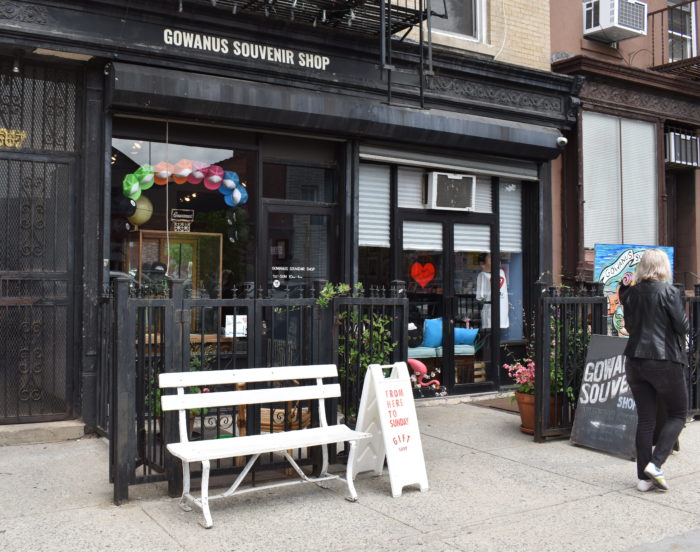
The shop is on Union Street, not far from such attractions as Ample Hills Creamery and Pig Beach
Before opening the shop, Zimmermann worked in the nonprofit arts world and had never run a business. But she has come to like her newfound, transactional way of promoting art. “It’s a much more straightforward interaction,” she said. “Now instead of asking people for a donation, “I can say, ‘That’s $32.99.’”
Zimmermann’s time in business has taught her a couple of things she wished she had known when starting. “Don’t ever pay for advertising,” she said, singling out a bad experience with Yelp. “I gave them 300 bucks a month for four clicks.” She has found more success in attracting journalism, she said, from outlets including the German newspaper Die Zeit, a Japanese travel magazine, and in-flight magazines for Air France and United Airlines. Zimmermann also gets traffic from word of mouth and through posting on Instagram.
Her business is also helped by having a good relationship with her landlords, whose home is on the same lot. Their kids “love coming by the shop to check out the new candy I have,” she said. A heartfelt letter from one of the children hangs by the cash register at the shop.
Zimmermann also credits her business partners. Joel Beck, an artist, co-founded the business with her and renovated its current location. Zimmermann has partnered with Diana Ho, an artist who first worked for her as a shopkeeper. Now Ho rents a fourth of the space for her own business, an arts-and-gifts shop called From Here to Sunday. She also splits shopkeeping hours with Zimmermann, and both sell each other’s work when the other isn’t in the shop.
“We help each other out,” she said.